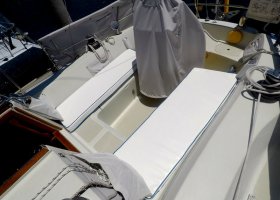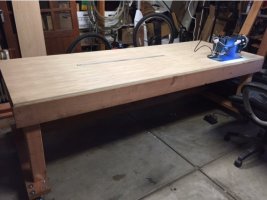I like sewing stuff for the boat, but sometimes I shake my head at the time it takes to measure, plan, order materials, prep, cut, stitch and fit.
After five years I finally bought a Sailrite LSZ-1. Yes, it can sew through just about anything that fits under the needle.
But my home machines can do almost everything else.
The walking-foot feature of professional machines is useful, but doesn't replace having to manhandle, stretch, pull and guide material through the needle alley.
That's because we don't have a sail loft to lay cloth out on, or a cutaway sewing table large enough to hold any project larger than a hatch cover.
Meaning, we still have to forcefully guide large bundles of cloth--and if you have to do that, a walking foot adds little to the standard home machine features.
One thing widely acknowledged as true: today's sewing machines, with plastic gears, are unsuitable for the rigors of Sunbrella or canvas work.
Older sewing machines, manufactured of steel literally by the millions, are virtually indestructible and up to the job.
Here's the report, and my take on whether a sewing machine is worth the trouble:
https://www.youtube.com/watch?v=9atUZ1656zg

After five years I finally bought a Sailrite LSZ-1. Yes, it can sew through just about anything that fits under the needle.
But my home machines can do almost everything else.
The walking-foot feature of professional machines is useful, but doesn't replace having to manhandle, stretch, pull and guide material through the needle alley.
That's because we don't have a sail loft to lay cloth out on, or a cutaway sewing table large enough to hold any project larger than a hatch cover.
Meaning, we still have to forcefully guide large bundles of cloth--and if you have to do that, a walking foot adds little to the standard home machine features.
One thing widely acknowledged as true: today's sewing machines, with plastic gears, are unsuitable for the rigors of Sunbrella or canvas work.
Older sewing machines, manufactured of steel literally by the millions, are virtually indestructible and up to the job.
Here's the report, and my take on whether a sewing machine is worth the trouble:
https://www.youtube.com/watch?v=9atUZ1656zg




